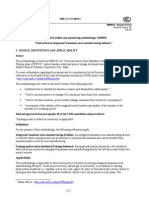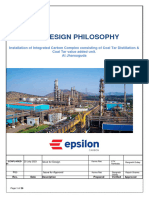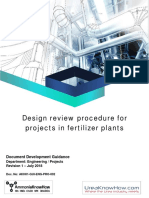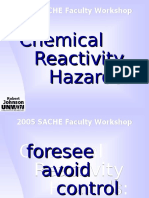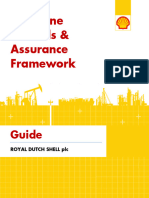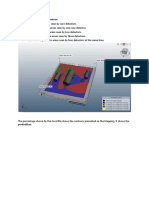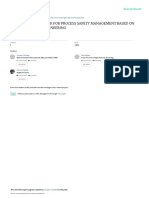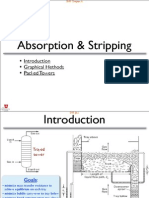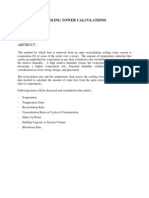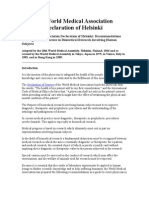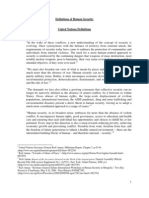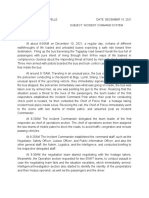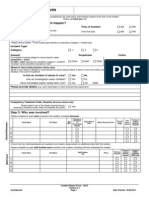0 ratings0% found this document useful (0 votes)
187 viewsInherent Safety
Inherent Safety
Uploaded by
Audrey Patrick Kallachemical process control
Copyright:
Attribution Non-Commercial (BY-NC)
Available Formats
Download as PDF, TXT or read online from Scribd
Inherent Safety
Inherent Safety
Uploaded by
Audrey Patrick Kalla0 ratings0% found this document useful (0 votes)
187 views28 pageschemical process control
Original Title
Inherent Safety (2)
Copyright
© Attribution Non-Commercial (BY-NC)
Available Formats
PDF, TXT or read online from Scribd
Share this document
Did you find this document useful?
Is this content inappropriate?
chemical process control
Copyright:
Attribution Non-Commercial (BY-NC)
Available Formats
Download as PDF, TXT or read online from Scribd
Download as pdf or txt
0 ratings0% found this document useful (0 votes)
187 views28 pagesInherent Safety
Inherent Safety
Uploaded by
Audrey Patrick Kallachemical process control
Copyright:
Attribution Non-Commercial (BY-NC)
Available Formats
Download as PDF, TXT or read online from Scribd
Download as pdf or txt
You are on page 1of 28
Copyright 2011, Jacobs Engineering Group Inc. All rights reserved.
Principles of Inherent Safe Design
Jo Fearnley
CIE Conference
10 May 2011
Copyright 2011, Jacobs Engineering Group Inc. All rights reserved. May 2011 | Slide 2
Fxborough 1974
Copyright 2011, Jacobs Engineering Group Inc. All rights reserved. May 2011 | Slide 3
Presentation outline
What is inherent safety?
Inherent safety implementation techniques
Conflicts in inherent safety
Human factors and inherent safety issues
Copyright 2011, Jacobs Engineering Group Inc. All rights reserved. May 2011 | Slide 4
Definition
Inherent safety:
An approach to process design and operation
which builds in safety, health and
environmental considerations at the start
Copyright 2011, Jacobs Engineering Group Inc. All rights reserved. May 2011 | Slide 5
Definition
Inherent safety:
What you dont have cant leak!
Trevor Kletz 1978
Copyright 2011, Jacobs Engineering Group Inc. All rights reserved. May 2011 | Slide 6
Definition
Inherent safety:
A low level of danger, even if something goes
wrong
Wikipedia.
Copyright 2011, Jacobs Engineering Group Inc. All rights reserved. May 2011 | Slide 7
Inherently safer design
In reality no design can be inherently safe
However you can have an inherently safer design
Copyright 2011, Jacobs Engineering Group Inc. All rights reserved. May 2011 | Slide 8
Inherently safer guidewords
Guideword description
Substitute Replace a substance with a less hazardous material or processing route
with one that does not involve hazardous material. Replace a hazardous
procedure with one that is less hazardous.
Minimise Use smaller quantities of hazardous materials when the use of
such materials cannot be avoided - also called intensification.
Perform a hazardous procedure as few times as possible when
the procedure is unavoidable.
Moderate Use hazardous materials in their least hazardous forms or identify
processing options that involve less severe processing conditions -
also called attenuation or limitation of effects.
Simplify Design processes, processing equipment and procedures to
eliminate opportunities for errors by eliminating excessive use of add-on
(engineered) safety features and protective devices - also called error
tolerance. Less equipment of any kind means that there is less
to go wrong.
Copyright 2011, Jacobs Engineering Group Inc. All rights reserved. May 2011 | Slide 9
Other options not inherent safety
Reduce consequential harm
risk to people is dependent on their presence in the
harm zone
risk to environment is dependent on the sensitivity
of species within the harm zone
risk to asset is not location specific
Copyright 2011, Jacobs Engineering Group Inc. All rights reserved. May 2011 | Slide 10
Other options not inherent safety
Locate process in region with no harm consequences
is it justified to release hazardous material into an area
which has
low population numbers
no special environmental features?
in the UK severity of harm is based on
people number of fatalities and injuries estimated
environment potential for a major accident to the
environment (MATTE) which is relative to the special
features nearby
Copyright 2011, Jacobs Engineering Group Inc. All rights reserved. May 2011 | Slide 11
Other obvious options
Design piping for maximum pressure and temperature
under fault conditions rather than installing pressure
and temperature trips
Minimise pipe route lengths to limit quantity available
to leak
Use all welded lines
Select materials of construction for the worst case
conditions they could see, not the normal conditions
Design support structures for the worst credible
external events such as wind, flood, earthquake, fire
Copyright 2011, Jacobs Engineering Group Inc. All rights reserved. May 2011 | Slide 12
Layers of process safety
Copyright 2011, Jacobs Engineering Group Inc. All rights reserved. May 2011 | Slide 13
Layers of process safety - inherent
Ideally this means eliminating the hazard from the
design
Copyright 2011, Jacobs Engineering Group Inc. All rights reserved. May 2011 | Slide 14
Layers of process safety - passive
This is building the protection into the design so it cannot
be (easily) changed
Reduce frequency and / or consequence of hazard
e.g. design conditions should mean that process
cannot move outside of the safe envelope under
any circumstances however external factors such
as external damage exist
future design / process changes could invalidate
protection
Copyright 2011, Jacobs Engineering Group Inc. All rights reserved. May 2011 | Slide 15
Layers of process safety - active
These layers are intended to prevent, control or mitigate
a potentially hazardous scenario: e.g.
Prevent: high level trip isolates flow into a tank before
it can overfill and lose containment
Control: a restrictive orifice plate limits the rate of loss
of containment if a line fails
Mitigate: heat activated links open deluge valves to
spray water in case of fire
Copyright 2011, Jacobs Engineering Group Inc. All rights reserved. May 2011 | Slide 16
Layers of process safety - procedural
These are systems which are intended to manage risk
Safety / process management system (SMS) / (PMS)
company policy
site rules
operating procedures
training / refresher training
maintenance and inspection regimes
test procedures and schedules
emergency response plans (on- and off- site)
Copyright 2011, Jacobs Engineering Group Inc. All rights reserved. May 2011 | Slide 17
Tolerability of risk - ALARP
Copyright 2011, Jacobs Engineering Group Inc. All rights reserved. May 2011 | Slide 18
Presentation outline
What is inherent safety?
Inherent safety implementation techniques
Conflicts in inherent safety
People and inherent safety issues
Copyright 2011, Jacobs Engineering Group Inc. All rights reserved. May 2011 | Slide 19
Inherent safety implementation techniques
Constructive questioning for example:
Is it necessary?
Why do it that way?
Why that material?
Why so much?
How can we make it simpler?
Copyright 2011, Jacobs Engineering Group Inc. All rights reserved. May 2011 | Slide 20
Inherent safety implementation techniques
Alternatives for lower impact?
Alternatives to minimise inventories?
Alternatives for benign process conditions?
Ultimate fate of all substances?
Designed for minimum purges?
Designed for minimum effluent & waste disposal?
Designed to minimise consequences of releases?
Impact of increased SH&E standards on costs?
Copyright 2011, Jacobs Engineering Group Inc. All rights reserved. May 2011 | Slide 21
Presentation outline
What is inherent safety?
Inherent safety implementation techniques
Conflicts in inherent safety
People and inherent safety issues
Copyright 2011, Jacobs Engineering Group Inc. All rights reserved. May 2011 | Slide 22
Conflicts in inherent safety
Inherent Safety is not always obvious
Cost implications
Flexibility
Personal choice
Balance of demands
Judgement
Information available
etc etc
Copyright 2011, Jacobs Engineering Group Inc. All rights reserved. May 2011 | Slide 23
Conflicts in inherent safety
Inherent safety design depends on extent of
understanding:
Experience of people
Experience of process
Industry knowledge
History of incidents
Data availability (e.g. MSDS, compatibility, etc)
New / novel / innovative then what??
Copyright 2011, Jacobs Engineering Group Inc. All rights reserved. May 2011 | Slide 24
Presentation outline
What is inherent safety?
Inherent safety implementation techniques
Conflicts in inherent safety
Human factors and inherent safety issues
Copyright 2011, Jacobs Engineering Group Inc. All rights reserved. May 2011 | Slide 25
Human factors and inherent safety issues
Task design / workload
Motivation
Complexity
Time available in which to
make a decision
Procedures design ease of
reference, correct, detailed
Communications
Organisational structure
Management attitude
production is more important
than safety
Non-compliance with
standards accepted as
normal
Poor training / inexperience
Lack of self belief (in ability
to make correct decision)
Poor design (too many
alarms arising so ignores
them no distinction of
important alarms)
Colour blind
Too busy / distracted
Poor environment (too hot /
cold / cramped / poor lighting
/ layout not conductive to
seeing fault warning)
Misleading information
Alarm fault ( e.g. alarm often
in spuriously, so ignored)
Stress / fatigue / boredom
Copyright 2011, Jacobs Engineering Group Inc. All rights reserved. May 2011 | Slide 26
Contact details
Please make contact through Jo Fearnley, Principal Consultant
Jacobs
Consultancy Services
Phoenix House
3 Surtees Way
Surtees Business Park
Stockton-on-Tees
TS18 3HR
Tel: +44 (0)1642 334 053 (direct dial)
Mob: +44 (0)7799 343 392
jo.fearnley@jacobs.com www.jacobs.com
Copyright 2011, Jacobs Engineering Group Inc. All rights reserved. May 2011 | Slide 27
Copyright
Copyright of all published material including photographs, drawings and images in this document remains vested
in Jacobs and third party contributors as appropriate. Accordingly, neither the whole nor any part of this document
shall be reproduced in any form nor used in any manner without express prior permission and applicable
acknowledgements. No trademark, copyright or other notice shall be altered or removed from any reproduction.
Copyright 2011, Jacobs Engineering Group Inc. All rights reserved. May 2011 | Slide 28
Disclaimer
This Presentation includes and is based, inter alia, on forward-looking information and statements that are subject
to risks and uncertainties that could cause actual results to differ. These statements and this Presentation are
based on current expectations, estimates and projections about global economic conditions, the economic
conditions of the regions and industries that are major markets for Jacobs Engineering Group Inc. (including
subsidiaries and affiliates) lines of business. These expectations, estimates and projections are generally
identifiable by statements containing words such as expects, believes, estimates or similar expressions.
Important factors that could cause actual results to differ materially from those expectations include, among
others, economic and market conditions in the geographic areas and industries that are or will be major markets
for Jacobs businesses, oil prices, market acceptance of new products and services, changes in governmental
regulations, interest rates, fluctuations in currency exchange rates and such other factors as may be discussed
from time to time in the Presentation. Although Jacobs Engineering Group Inc. believes that its expectations and
the Presentation are based upon reasonable assumptions, it can give no assurance that those expectations will be
achieved or that the actual results will be as set out in the Presentation. Jacobs Engineering Group Inc. is making
no representation or warranty, expressed or implied, as to the accuracy, reliability or completeness of the
Presentation, and neither Jacobs Engineering Inc. nor any of its directors, officers or employees will have any
liability to you or any other persons resulting from your use.
Jacobs consists of many legally independent entities, constituting their own separate identities. Jacobs is used as
the common brand or trade mark for most of these entities. In this presentation we may sometimes use Jacobs,
we or us when we refer to Jacobs companies in general or where no useful purpose is served by identifying
any particular Jacobs company.
You might also like
- (BP Process Safety Series) - Hazards of Trapped Pressure and Vacuum-Institution of Chemical Engineers (2009)Document100 pages(BP Process Safety Series) - Hazards of Trapped Pressure and Vacuum-Institution of Chemical Engineers (2009)DanielNo ratings yet
- Technology Selection For A Chemical Process GuidelinesDocument9 pagesTechnology Selection For A Chemical Process GuidelinesrutujaNo ratings yet
- Macedonia Visa Permit PDFDocument27 pagesMacedonia Visa Permit PDFVMRO75% (4)
- Collapse of SphereDocument2 pagesCollapse of SphereAjit DyahadrayNo ratings yet
- HSE Front End Loading ProcedureDocument11 pagesHSE Front End Loading ProcedureVasilica BarbarasaNo ratings yet
- Humber RefineryDocument2 pagesHumber RefineryRatna Paramitha SariNo ratings yet
- Aerosol Paints Know How Plant Setting FormulationsDocument1 pageAerosol Paints Know How Plant Setting FormulationsAudrey Patrick Kalla67% (3)
- Emc WaiverDocument1 pageEmc WaiverZumbaShellNo ratings yet
- National Building Code 2005Document1,161 pagesNational Building Code 2005api-2617216889% (47)
- Fugitive Dust Control PlanDocument3 pagesFugitive Dust Control Plangabinuang100% (1)
- CL419 Cost Estimation 19 20Document94 pagesCL419 Cost Estimation 19 20Nikhil YadavNo ratings yet
- Cefic Solvay Guidelines PDFBR 1770 C-b-1-0602 - H2o2Document48 pagesCefic Solvay Guidelines PDFBR 1770 C-b-1-0602 - H2o2Mark CousinsNo ratings yet
- Client: BMT India Document: Terms of References For Quantitative Risk Assessment StudyDocument10 pagesClient: BMT India Document: Terms of References For Quantitative Risk Assessment StudyAnurag BholeNo ratings yet
- Offsites Engineering Works For The Erbil Refinery 40,000 B/D Expansion ProjectDocument56 pagesOffsites Engineering Works For The Erbil Refinery 40,000 B/D Expansion ProjectSardar Perdawood100% (1)
- CDM UNFCCC Ammonia Urea PlantDocument27 pagesCDM UNFCCC Ammonia Urea PlantSyukri ShahNo ratings yet
- Process Technology OrganizationDocument4 pagesProcess Technology OrganizationCivil FriendNo ratings yet
- Fire Protection Design Criteria 2352-6800-45DC-001 - R0Document13 pagesFire Protection Design Criteria 2352-6800-45DC-001 - R0DanyNo ratings yet
- Minimizing Fire Risk at CPI Facilities Volume 2Document113 pagesMinimizing Fire Risk at CPI Facilities Volume 2isleepinadrawer0% (1)
- ECAPL JSG HES Design PhilosophyDocument26 pagesECAPL JSG HES Design Philosophykanna gNo ratings yet
- FEED Technical Clarifications No1-PE7172 ConsolidatedDocument29 pagesFEED Technical Clarifications No1-PE7172 ConsolidatedAlok Kumar100% (1)
- Development of Basis of Design For Projects in Fertilizer Industry Document GuidanceDocument9 pagesDevelopment of Basis of Design For Projects in Fertilizer Industry Document GuidanceJak AshishNo ratings yet
- HSE Manual: Concept SelectionDocument43 pagesHSE Manual: Concept SelectionClive NicliNo ratings yet
- Chevron Equipment Spacing GuidelinesDocument2 pagesChevron Equipment Spacing GuidelinesJustin Ray100% (5)
- 100 Introduction To Fire PreventionDocument22 pages100 Introduction To Fire PreventionSHAILENDRANo ratings yet
- Webinar Occupied Buildings Risk Assessment Using Phast and Safeti PPTDocument34 pagesWebinar Occupied Buildings Risk Assessment Using Phast and Safeti PPTVu Hoang Vo100% (2)
- Oil and Chemical Plant Layout and Spacing PDFDocument13 pagesOil and Chemical Plant Layout and Spacing PDFtiffanyyy00No ratings yet
- Design Review Procedure For Projects in Fertilizer PlantsDocument9 pagesDesign Review Procedure For Projects in Fertilizer PlantsmanuNo ratings yet
- Risk Based SpacingDocument14 pagesRisk Based SpacingNaresh NutakkiNo ratings yet
- I R C A L: Quantitative Risk Assessment of Mounded Bullet ProjectDocument77 pagesI R C A L: Quantitative Risk Assessment of Mounded Bullet ProjectRenato BenintendiNo ratings yet
- 7 Work Packages Deliverables Milestones PDFDocument10 pages7 Work Packages Deliverables Milestones PDFSulist N WahyudieNo ratings yet
- 5 Data Centric EngineeringDocument23 pages5 Data Centric EngineeringClémentNo ratings yet
- Plant Siting & Layout PDFDocument48 pagesPlant Siting & Layout PDFAlejandra Quintin100% (2)
- Chemical Reactivity HazardsDocument101 pagesChemical Reactivity HazardsSandeep VermaNo ratings yet
- DCAF GuideDocument34 pagesDCAF GuideANo ratings yet
- Inherently Safer DesignDocument64 pagesInherently Safer Designchetan_7927No ratings yet
- Commissioning of BFPLDocument11 pagesCommissioning of BFPLsaravananknpcNo ratings yet
- 000.225.1000 Licensor Evaluation & SelectionDocument10 pages000.225.1000 Licensor Evaluation & SelectionMuhammad Fatah ShaikNo ratings yet
- Hazards and Operability (HAZOP) StudyDocument28 pagesHazards and Operability (HAZOP) StudyXiang Jintao100% (1)
- Idbu-Ed-Fspds-000014 Rev C (Human Factor)Document113 pagesIdbu-Ed-Fspds-000014 Rev C (Human Factor)aan2014211No ratings yet
- DSR Book Vol 2 2016 (English Version) FinalDocument113 pagesDSR Book Vol 2 2016 (English Version) Finalprasad100% (1)
- Project Risk Management - PEROT SYSTEMSDocument44 pagesProject Risk Management - PEROT SYSTEMSGustavo Gonzalez ServaNo ratings yet
- Basic Design and Engineering Package PDFDocument164 pagesBasic Design and Engineering Package PDFSswahyudi100% (7)
- Key Notes For Fire and Gas MappingDocument4 pagesKey Notes For Fire and Gas MappingAhmad MuzammilNo ratings yet
- Project Control Reporting On Lump Sum ProjectDocument6 pagesProject Control Reporting On Lump Sum ProjectKurniawanNo ratings yet
- Practical Framework For Process Safety ManagementDocument13 pagesPractical Framework For Process Safety ManagementSubhi El Haj Saleh100% (1)
- 213 - Procedure - 0-Project Multi-Office Engineering Execution PlanDocument9 pages213 - Procedure - 0-Project Multi-Office Engineering Execution PlanagaricusNo ratings yet
- KBK Terminal One Proposal - PMCDocument7 pagesKBK Terminal One Proposal - PMCVinay Srivastava100% (1)
- HAZID PresentationDocument11 pagesHAZID PresentationAlvian FachrurroziNo ratings yet
- Instructions: Landing Loss EmissionsDocument15 pagesInstructions: Landing Loss Emissionssunildubey02No ratings yet
- Engineering EstimateDocument16 pagesEngineering EstimateLixin YangNo ratings yet
- White Paper PDRIDocument10 pagesWhite Paper PDRIhumberto zuletaNo ratings yet
- Standardization of Bid EvaluationDocument9 pagesStandardization of Bid Evaluationomoba solaNo ratings yet
- AHF Equipment For HandlingDocument48 pagesAHF Equipment For HandlingShailesh Raval100% (1)
- Align Your Automation Plan To Your Business Objectives: Front End Engineering Design CapabilitiesDocument4 pagesAlign Your Automation Plan To Your Business Objectives: Front End Engineering Design CapabilitiestechbhaskarNo ratings yet
- Tender8831 PDFDocument123 pagesTender8831 PDFsumitNo ratings yet
- 2 - Robuste Risikoanalyser - Linda Fløttum Og Tore Andre SvidalDocument33 pages2 - Robuste Risikoanalyser - Linda Fløttum Og Tore Andre SvidalNurhayati Muhamad NorNo ratings yet
- 5.7 Hazop V1.0Document25 pages5.7 Hazop V1.0marius_brkt6284No ratings yet
- Safety in Design (SiD) Guidelines V1 0Document19 pagesSafety in Design (SiD) Guidelines V1 0Umar Kida67% (3)
- Chemical Engineering Plant Design Lect 8Document50 pagesChemical Engineering Plant Design Lect 8Eleazar Al GuzmanNo ratings yet
- Lesson 1-2 CH4101 Intro, Inherent SafetyDocument47 pagesLesson 1-2 CH4101 Intro, Inherent SafetyTang Voon HaoNo ratings yet
- Segur EmcDocument8 pagesSegur EmcPepe ShayloverNo ratings yet
- Ase Text Book Chapter 1Document16 pagesAse Text Book Chapter 1Vinay DattaNo ratings yet
- Lecture 7 Industrial Safety - BDocument22 pagesLecture 7 Industrial Safety - BRain bowNo ratings yet
- 5 StereoisomersDocument37 pages5 StereoisomersAudrey Patrick KallaNo ratings yet
- Unit Operations and Processes in Environmental EngineeringDocument815 pagesUnit Operations and Processes in Environmental EngineeringAudrey Patrick Kalla89% (28)
- AbsorptionStripping PDFDocument25 pagesAbsorptionStripping PDFJuan Camilo HenaoNo ratings yet
- Chapter 1 - Process DiagramsDocument36 pagesChapter 1 - Process Diagramsmrajim93No ratings yet
- Absorption ColumnsDocument55 pagesAbsorption ColumnsAudrey Patrick KallaNo ratings yet
- Safety and Security Emergency Plan For EVENTDocument11 pagesSafety and Security Emergency Plan For EVENTAudrey Patrick KallaNo ratings yet
- Ads or PtionDocument141 pagesAds or PtionAudrey Patrick KallaNo ratings yet
- Chemical Process DesignDocument93 pagesChemical Process DesignAudrey Patrick Kalla50% (2)
- Ammonia StorageDocument6 pagesAmmonia Storagemsathishkm3911No ratings yet
- Chapter 10 - QDocument32 pagesChapter 10 - Qmohammedakbar88No ratings yet
- 09.electromagntic and Faraday Law - InductionDocument53 pages09.electromagntic and Faraday Law - InductionAudrey Patrick KallaNo ratings yet
- EiaDocument16 pagesEiaAudrey Patrick KallaNo ratings yet
- .Cost EstimationDocument15 pages.Cost EstimationAudrey Patrick KallaNo ratings yet
- Heat ExchangerDocument16 pagesHeat ExchangerAudrey Patrick KallaNo ratings yet
- Magnetic Fields: PHYS102 Previous Exam ProblemsDocument11 pagesMagnetic Fields: PHYS102 Previous Exam ProblemsAudrey Patrick KallaNo ratings yet
- Paint Testing ChartDocument39 pagesPaint Testing ChartAudrey Patrick Kalla0% (1)
- Energy Survey For Boiler and Plant OperationsDocument8 pagesEnergy Survey For Boiler and Plant OperationsJean RisquezNo ratings yet
- 84 enDocument6 pages84 enNomaan AsimNo ratings yet
- Cooling Tower ArticleDocument7 pagesCooling Tower ArticleAudrey Patrick KallaNo ratings yet
- Paint and Coating ProcessesDocument65 pagesPaint and Coating ProcessesAudrey Patrick Kalla100% (1)
- T6TYskLrXGMCXL93cXXEH9Ev9Document1 pageT6TYskLrXGMCXL93cXXEH9Ev9Sidrah RasoolNo ratings yet
- UHS MDCAT 2019 Advertisement Ajk PDFDocument3 pagesUHS MDCAT 2019 Advertisement Ajk PDFTanveer ShahzadNo ratings yet
- Mayors Request 440 Budgeted SendDocument56 pagesMayors Request 440 Budgeted Sendkarasa1No ratings yet
- Beyond Biden - Rebuilding The America We LoveDocument253 pagesBeyond Biden - Rebuilding The America We LoveJames SerranoNo ratings yet
- AIIMS Bibinagar AdvDocument7 pagesAIIMS Bibinagar AdvShashank Shekher JhaNo ratings yet
- On of HelsinkiDocument4 pagesOn of Helsinkiapi-3810976No ratings yet
- Tobacco SurveyDocument3 pagesTobacco SurveySamuel PascualNo ratings yet
- Definitions of Human SecurityDocument10 pagesDefinitions of Human SecurityClandestain Zee100% (2)
- Richard White, CEO of ShelterPoint Life Insurance Company, Joins LICONY's Board of DirectorsDocument3 pagesRichard White, CEO of ShelterPoint Life Insurance Company, Joins LICONY's Board of DirectorsPR.comNo ratings yet
- CDM 2015 CIBSE TalkDocument44 pagesCDM 2015 CIBSE TalkJeduardo Ch-meza100% (1)
- Scenario: Name: 1C Eloisa C. Wapelle DATE: DECEMBER 15, 2021 SECTION: 3 CL 2022 Subject: Incident Command SystemDocument3 pagesScenario: Name: 1C Eloisa C. Wapelle DATE: DECEMBER 15, 2021 SECTION: 3 CL 2022 Subject: Incident Command SystemEloisa WapelleNo ratings yet
- Devolution of Health ServicesDocument2 pagesDevolution of Health ServicesNoelle FabrosNo ratings yet
- TransCelerate 21CFRpart312 Statement of Investigator Guidance JUNE 2015Document2 pagesTransCelerate 21CFRpart312 Statement of Investigator Guidance JUNE 2015Bilal AnsariNo ratings yet
- Sag-Aftra Health Plan MTDDocument34 pagesSag-Aftra Health Plan MTDTHROnlineNo ratings yet
- NIRB Letter To Clyde River HTO Re: Participant FundingDocument3 pagesNIRB Letter To Clyde River HTO Re: Participant FundingNunatsiaqNewsNo ratings yet
- Teacher'S Class Program: School Year 2022-2023Document2 pagesTeacher'S Class Program: School Year 2022-2023JENNIFER YBAÑEZNo ratings yet
- Fire Dept Standard Operating Procedures Manual 2011Document242 pagesFire Dept Standard Operating Procedures Manual 2011crispix2000No ratings yet
- Basic Escort 2010Document190 pagesBasic Escort 2010lucamorlando100% (1)
- Harvard Referencing Style SpecificDocument16 pagesHarvard Referencing Style SpecificHJames SmithNo ratings yet
- PEZA Citizen's Charter PDFDocument154 pagesPEZA Citizen's Charter PDFRomer LesondatoNo ratings yet
- Office of The District Medical & Health OfficerDocument28 pagesOffice of The District Medical & Health OfficerJaideep ChungiNo ratings yet
- Suffolk Times Classifieds and Service Directory: June 8, 2017Document15 pagesSuffolk Times Classifieds and Service Directory: June 8, 2017Timesreview100% (1)
- Incident Reporting Form Hand Written HealthDocument6 pagesIncident Reporting Form Hand Written HealthCarmen Dumitru100% (1)
- QUALIFY Synonyms: 107 Synonyms & Antonyms For QUALIFY - Thesaurus-2Document1 pageQUALIFY Synonyms: 107 Synonyms & Antonyms For QUALIFY - Thesaurus-2SamuelNo ratings yet
- The Lahore Development Authority Act, 1975 (XXX OF 1975) : Establishment of Housing Schemes, Projects EtcDocument27 pagesThe Lahore Development Authority Act, 1975 (XXX OF 1975) : Establishment of Housing Schemes, Projects EtcSalman QureshiNo ratings yet
- National Human Rights Action Plan (NHRAP) : As of 7 February 2011Document2 pagesNational Human Rights Action Plan (NHRAP) : As of 7 February 2011Muna RimeNo ratings yet
- Recommendations For Terminology, Abbreviations and Symbols Used in The Prescribing and Administration of MedicinesDocument8 pagesRecommendations For Terminology, Abbreviations and Symbols Used in The Prescribing and Administration of Medicinesdarkheart1804No ratings yet
- Tower Crane LiftDocument10 pagesTower Crane LiftVan PijeNo ratings yet














